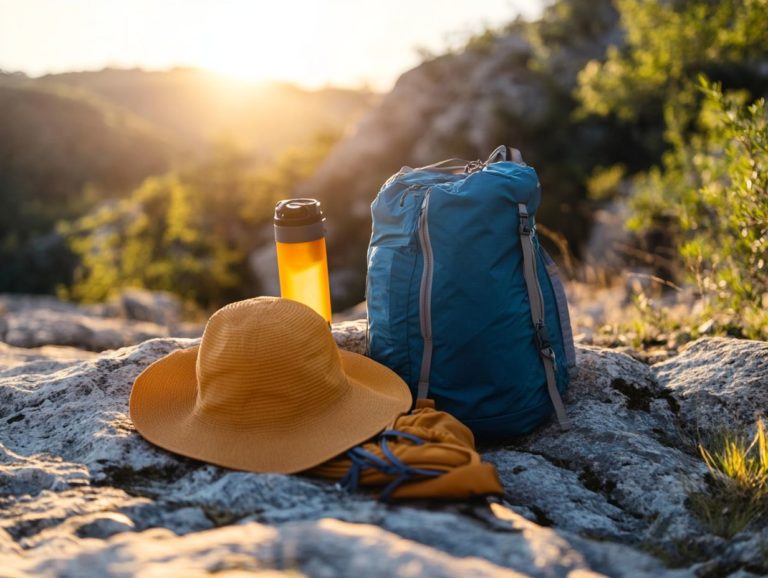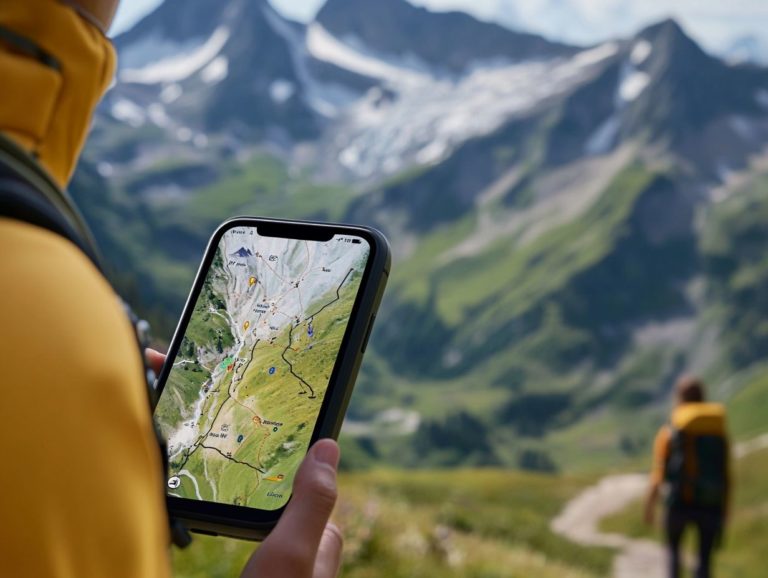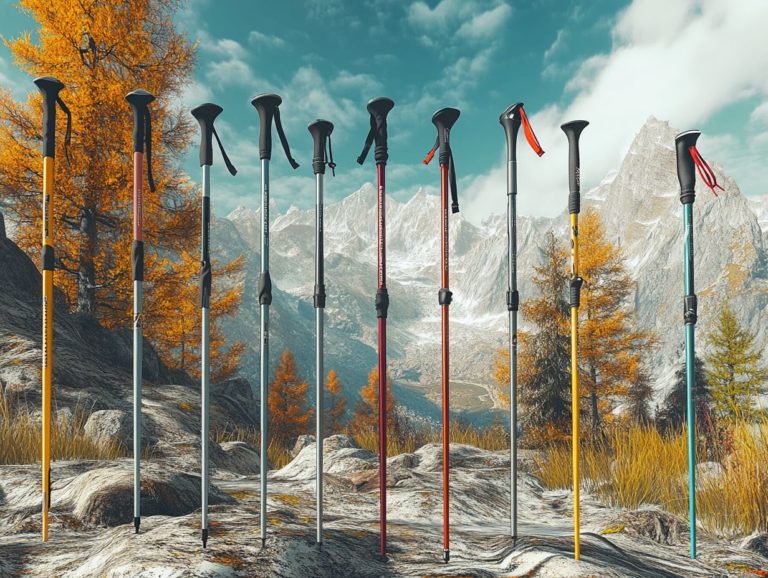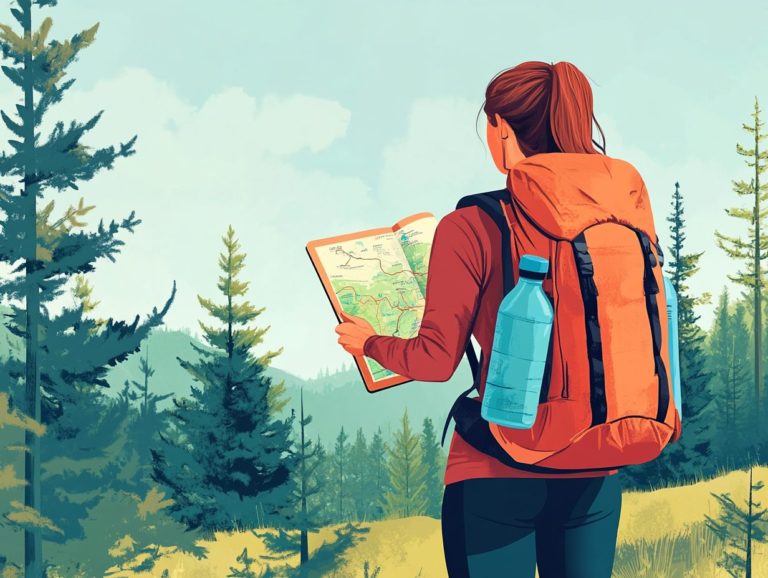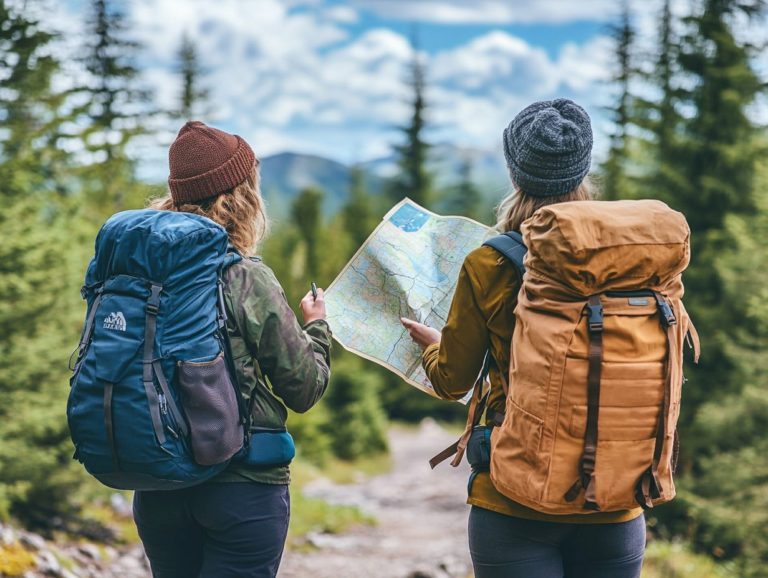Top Hiking Gear Accessories You Need
Embarking on a hiking adventure requires more than just a passion for the great outdoors; it calls for the right gear to guarantee your safety, comfort, and great memories.
Whether you’re a seasoned trekker or a weekend warrior, don t miss out on essential hiking gear that will transform your journey. From sturdy hiking boots to reliable navigation tools, this guide outlines the top gear you need to optimize your outdoor escapades.
Get ready for adventure! Each hike can create amazing memories!
Contents
- Key Takeaways:
- 1. Hiking Boots
- 2. Backpack
- 3. Navigation Tools
- 4. Water Bottle
- 5. Sun Protection
- 6. Headlamp/Flashlight
- 7. First Aid Kit
- 8. Multi-Tool
- 9. Trekking Poles
- 10. Insect Repellent
- 11. Rain Gear
- 12. Emergency Shelter
- 13. Portable Stove and Cookware
- 14. Extra Clothing Layers
- 15. Camera/Phone for Capturing Memories
- Frequently Asked Questions
- What are the top hiking gear accessories I need for my next adventure?
- Why is a backpack considered an essential hiking gear accessory?
- Do I really need hiking boots or can I use regular sneakers?
- What type of navigation tools should I bring for a successful hike?
- How can I protect myself from the sun while hiking?
- Are there any other hiking gear accessories I should consider bringing?
Key Takeaways:
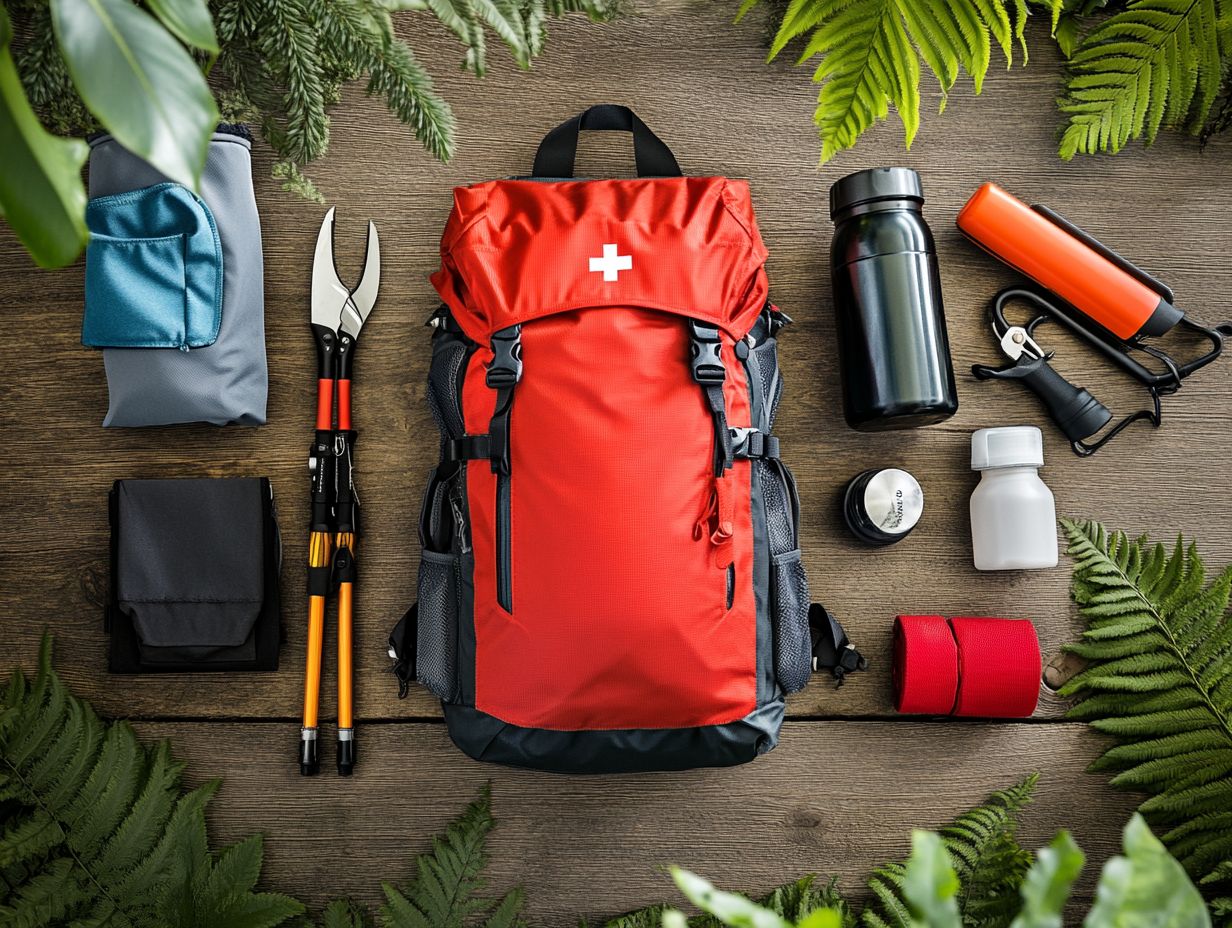
- Invest in a good pair of hiking boots to protect your feet and provide comfort on long hikes.
- Always pack a backpack with essential items like water, food, and emergency supplies.
- Bring tools that help you find your way, such as a map and compass, to ensure you stay on the right trail.
1. Hiking Boots
Hiking boots are a must-have for any outdoor adventure. They provide not just support and durability but also ensure that your hiking experience remains comfortable and safe, no matter the terrain you encounter.
Choosing the right pair of hiking shoes or boots can significantly enhance your comfort on the trail. This allows you to traverse various hiking paths without the constant worry of blisters or injuries.
Different types of hiking boots cater to your specific needs: lightweight options are perfect for day hikes where agility is key. In contrast, sturdier, more robust models offer the ankle support necessary for challenging treks.
Waterproofing is another critical factor to consider, especially if you find yourself hiking in wet or unpredictable climates.
Popular choices like the Osprey Hikelite 26 not only impress with their design but also excel in comfort and functionality. When selecting your footwear, remember that proper fit is paramount; a well-fitted boot ensures stability and significantly reduces the risk of injuries, leading to a safer hiking experience.
The right hiking footwear also elevates your overall performance, enabling you to enjoy longer and more pleasurable excursions into the great outdoors.
2. Backpack
A well-fitted hiking backpack is essential for your gear, acting as the perfect storage solution for all your essentials, from clothing layers to emergency kits.
With the right backpack, you’ll be thoroughly prepared for any adventure that awaits you in the great outdoors. Choosing the ideal hiking backpack isn’t merely about selecting a brand; it requires a keen understanding of the various types available, each tailored to different needs and conditions, including considerations for winter hiking gear essentials.
Take the Osprey Hikelite 26, for example. Its excellent weight distribution makes those long treks far more comfortable, while the convenient hydration reservoir ensures that you have easy access to water a critical element during strenuous hikes.
An ideal pack doesn t just accommodate your essentials; it enhances your convenience by allowing for quick adjustments while you re on the move. Efficient packing is equally vital; organizing your gear based on the hike’s duration and terrain can significantly impact your overall comfort and performance.
When you venture into the wilderness, having reliable navigation tools is essential for ensuring a safe and enjoyable hiking experience. These tools help you stay on track and confidently explore new trails.
Today’s adventurers have a plethora of options at their fingertips, ranging from classic hiking maps that offer a tangible sense of direction to modern GPS devices that provide real-time positioning.
Mobile apps like AllTrails and Gaia GPS have transformed the way you plan your routes, granting you easy access to user-generated content and detailed trail information.
Incorporating tools like the Garmin inReach Mini 2 can greatly enhance your safety. This compact device allows for two-way satellite messaging and emergency SOS capabilities, making it critical for unexpected situations.
Utilizing these advanced technologies not only elevates your hiking experience but also instills a greater sense of security and preparedness as you navigate the great outdoors.
4. Water Bottle
Staying hydrated is key while hiking. The right water bottle or hydration system can improve your comfort and performance on the trails.
With a range of materials at your disposal stainless steel, plastic, and glass each option presents unique advantages. Stainless steel bottles are known for their durability and insulation. Lightweight plastic bottles are perfect for long treks when every ounce counts. The size of your water bottle is also important; larger bottles mean fewer refills, but they can add extra weight to your pack.
Consider usability features like flip-top lids or built-in straws for added convenience as you navigate the great outdoors. Don t overlook the value of a dependable water filter, such as the Sawyer Squeeze Water Filter System. It ensures that, wherever your journey takes you, clean drinking water is accessible, keeping you hydrated and healthy.
5. Sun Protection
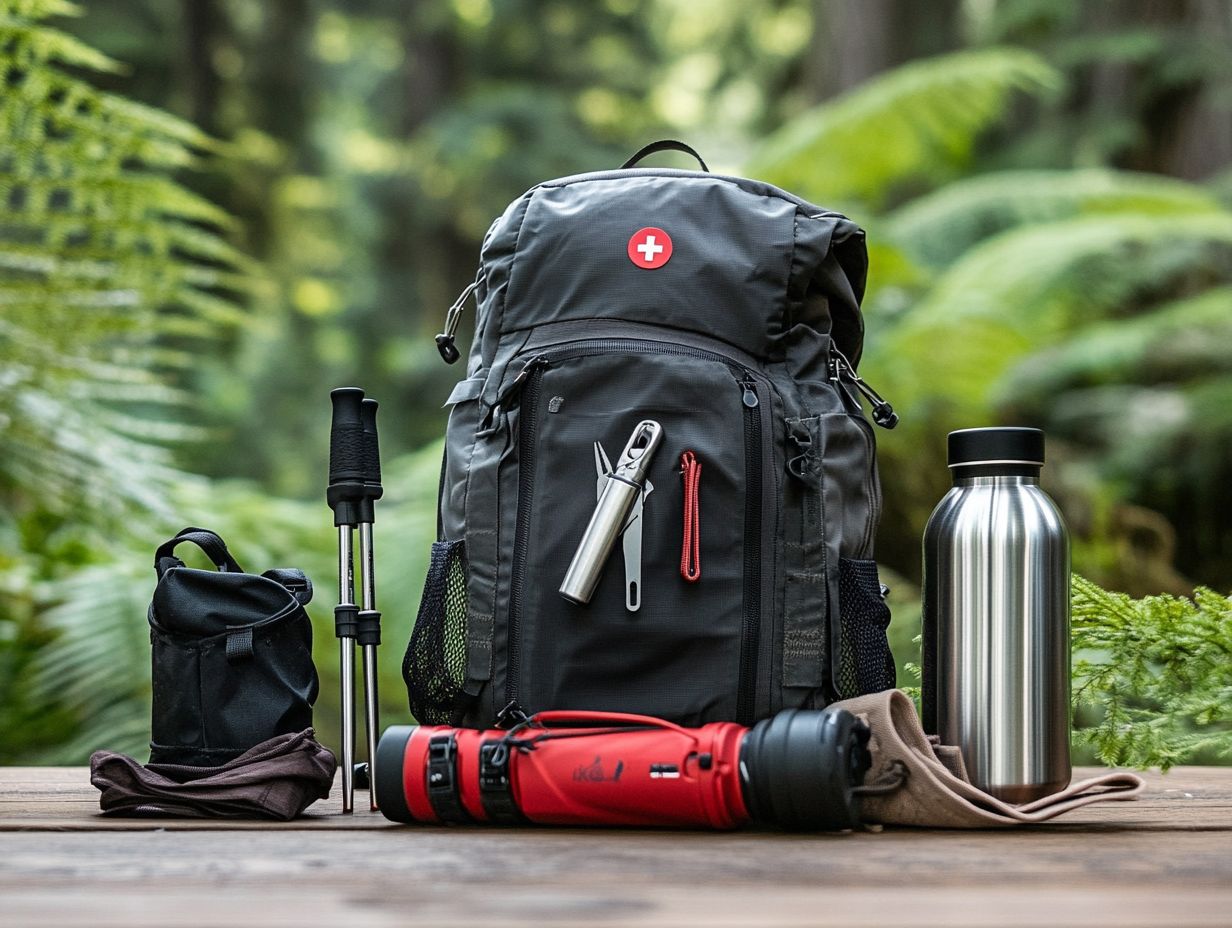
Proper sun protection is crucial for a safe and enjoyable hiking experience. Prolonged exposure to UV rays can lead to sunburn and other health concerns, so choosing the right gear is imperative.
This means not just applying sunscreen regularly, but also selecting clothing that effectively shields your skin. Lightweight, long-sleeve shirts made from breathable fabric are your best friends; they cover your arms while allowing for air circulation, keeping you comfortable on warm, sunny days.
Don’t forget about hats with broad brims! They provide vital defense against direct sunlight on your face and neck, which are often the most vulnerable areas. On cooler days when chilly temperatures collide with bright sunshine, consider options like the Patagonia Nano Puff Jacket. It delivers warmth while ensuring sun protection, making it a top choice for outdoor enthusiasts.
6. Headlamp/Flashlight
A reliable headlamp or flashlight is crucial! It ensures you can navigate safely when the sun goes down. It s a must-have component of your hiking essentials.
Among the variety of options available, headlamps often stand out for their hands-free functionality. This allows you to illuminate your path while keeping your gear within easy reach.
When considering brightness levels, flashlights typically range from 100 to over 1,000 lumens, delivering powerful beams for expansive visibility. In contrast, headlamps usually span from 50 to 800 lumens, making them perfect for close-up tasks and nearby navigation.
Battery life is another crucial consideration. Many modern headlamps and flashlights feature energy-efficient LEDs that can last anywhere from several hours to days on a single charge or set of batteries, depending on the mode you choose.
Ultimately, having a dependable light source can significantly enhance your safety during night hikes or unexpected emergencies, ensuring that every step you take is both confident and well-illuminated.
7. First Aid Kit
A well-stocked first aid kit is essential for your hiking preparation. It offers peace of mind and ensures you re equipped to handle minor injuries and emergencies that can occur during your outdoor adventures.
Whether it s a s scraped knee from navigating a rocky trail or a sudden allergic reaction to a bee sting, having a curated selection of supplies can truly make a world of difference. Include essential items such as:
- Adhesive bandages in various sizes
- Antiseptic wipes
- Gauze pads
- Elastic bandages for sprains
For more serious situations, specialized equipment like a thermal blanket, snake bite kit, or emergency whistle can be invaluable.
Regularly check your kit for expired items and restock after use. Stay prepared, and enjoy your hikes without worry!
8. Multi-Tool
A versatile multi-tool is one of the most practical hiking companions you can carry. It offers an array of functionalities that can assist you in various situations from fixing gear to preparing meals.
Opting for a lightweight design is crucial. It minimizes the burden on your back while maximizing utility.
Durability should also take precedence. The rugged outdoors can present significant challenges to your equipment.
When selecting a multi-tool, consider features such as:
- a strong pair of pliers,
- multiple knife blades,
- screwdrivers.
These elements can prove invaluable for quick adjustments and repairs on the go. Renowned options like the Leatherman Wave or the Gerber Suspension provide reliable tools without compromising on weight.
A quality multi-tool streamlines your gear and enhances your overall hiking experience. With it, you ll be ready for whatever the trail throws your way.
9. Trekking Poles
Trekking poles are an essential upgrade to your hiking gear. They offer support and stability on uneven terrain.
This added stability can significantly enhance your comfort and safety during long treks.
These versatile tools help distribute your body weight, reducing stress on your joints. This is particularly beneficial if you have knee issues or face steep descents.
Trekking poles also improve your balance. They allow you to navigate rocky paths and slippery surfaces with newfound confidence.
You ll find a variety of options available. There are lightweight models perfect for fast-paced day hikes and sturdier poles designed for challenging backcountry adventures.
Features like adjustable lengths ensure a perfect fit for your height and walking style. This makes them critical across varied terrains.
For casual walkers, a simple, collapsible option will do the trick. Those tackling rugged trails may lean toward poles with shock absorption for extra comfort throughout their journey.
10. Insect Repellent
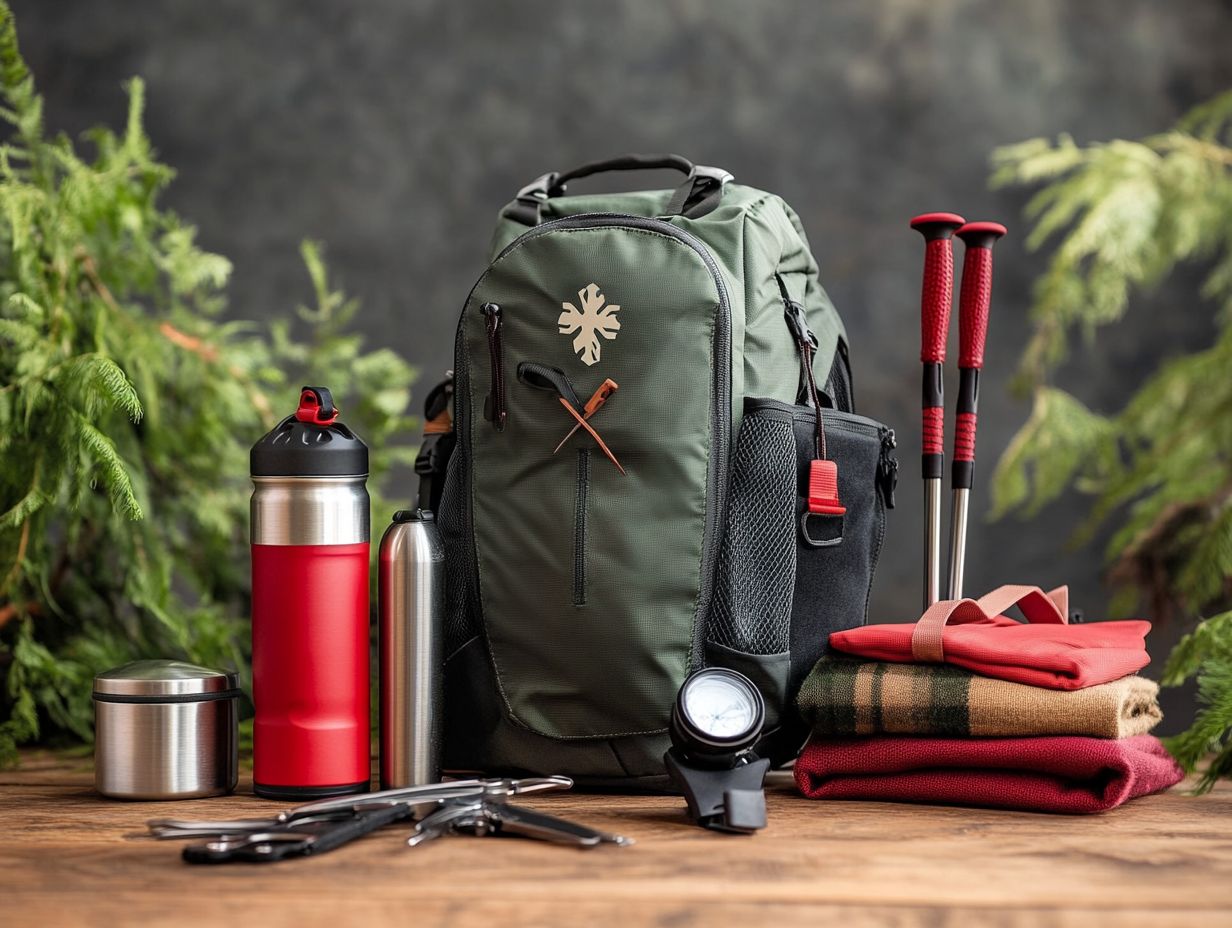
Insect repellent is an often-overlooked yet essential item in your hiking gear. It shields you from those pesky bites and potential diseases.
This allows you to immerse yourself in the beauty of nature without distractions.
When selecting an insect repellent, you have various options at your fingertips. These include sprays, lotions, and even wearable devices, each boasting its unique benefits.
Sprays can deliver quick coverage, but be mindful they may need reapplication after sweating or encountering moisture. Lotions not only protect but often nourish your skin, creating a longer-lasting barrier.
For those inclined toward a chemical-free approach, natural options are gaining popularity, although their effectiveness can vary.
Ultimately, prioritize your comfort and safety while reveling in the great outdoors. Get your insect repellent ready and enjoy the beauty of nature worry-free!
11. Rain Gear
Imagine tackling any trail, rain or shine, with the perfect rain gear at your side! Having the right rain gear is absolutely essential for your hiking experience.
It shields you from the elements and ensures you stay dry and comfortable when the weather takes a turn for the worse.
Choosing the appropriate attire can elevate your outdoor adventure to new heights. Durable jackets, waterproof pants, and versatile ponchos each serve distinct purposes.
This allows you to customize your gear to fit your specific needs.
In terms of materials, opting for high-quality options, like Gore-Tex a breathable waterproof material or nylon, offers exceptional water resistance.
These materials still allow your skin to breathe, which is crucial for preventing moisture buildup during intense hikes.
Features such as adjustable hoods, elastic cuffs, and ventilation zippers not only enhance comfort but also add convenience.
This makes each step through unpredictable weather a little more enjoyable.
In the end, investing in well-designed rain gear can unlock new trails and experiences. Don’t wait find the right gear today to prepare for unexpected weather!
12. Emergency Shelter
An emergency shelter is vital hiking gear. It shields you from unexpected weather, ensuring your safety and comfort.
These shelters come in various types. For example, bivy sacks are lightweight and insulated, while emergency blankets trap body heat and are compact.
Having an emergency shelter in your backpack is crucial. It protects you from sudden weather changes and helps if you get stranded.
When choosing an emergency shelter, consider weight and packability. A bivy sack may appeal to those who prioritize warmth and durability, while a mylar emergency blanket is perfect for those seeking something ultra-lightweight for swift maneuvers.
Ultimately, being prepared is key to an enjoyable outdoor experience, even in unexpected challenges.
13. Portable Stove and Cookware
A portable stove and cookware set can elevate your hiking experience. They allow you to prepare hot meals and beverages that provide comfort and nourishment during your adventures.
Explore the various options available. You’ll find several types of portable stoves, each with unique benefits.
- Compact canister stoves shine in terms of weight and convenience, making them a favorite among minimalist hikers.
- Wood-burning stoves are great if you prefer sustainable fuel sources that connect you with nature.
- Liquid fuel variants offer longer cooking times and consistent heat output, ensuring warmth for your culinary creations.
Each type has advantages regarding weight, fuel efficiency, and ease of use in diverse environments. Pack essential cookware items like lightweight pots, a compact pan, and a sturdy spatula. These can greatly enhance your overall comfort, ensuring delicious meals await after a long day on the trails.
14. Extra Clothing Layers
Don t hit the trails without extra clothing layers! They re your best defense against changing weather.
Understanding the significance of layering can elevate your hiking experience. Your base layer, typically made from moisture-wicking materials like Merino wool or synthetic fabrics, keeps sweat away from your skin an absolute must for regulating body temperature.
For insulating layers, consider fleece or down jackets. They provide warmth without bulk, making them perfect for chilly morning treks. An outer layer, such as a waterproof and breathable shell, acts as your shield against rain and wind, keeping you dry and comfortable on the trail. When selecting gear, check out the top hiking gear brands to consider for quality options.
Choosing the right combination of these layers can dramatically enhance your overall experience. Opt for lighter options in warmer months or more robust materials during colder seasons, and you ll find that thoughtful layering makes all the difference.
15. Camera/Phone for Capturing Memories
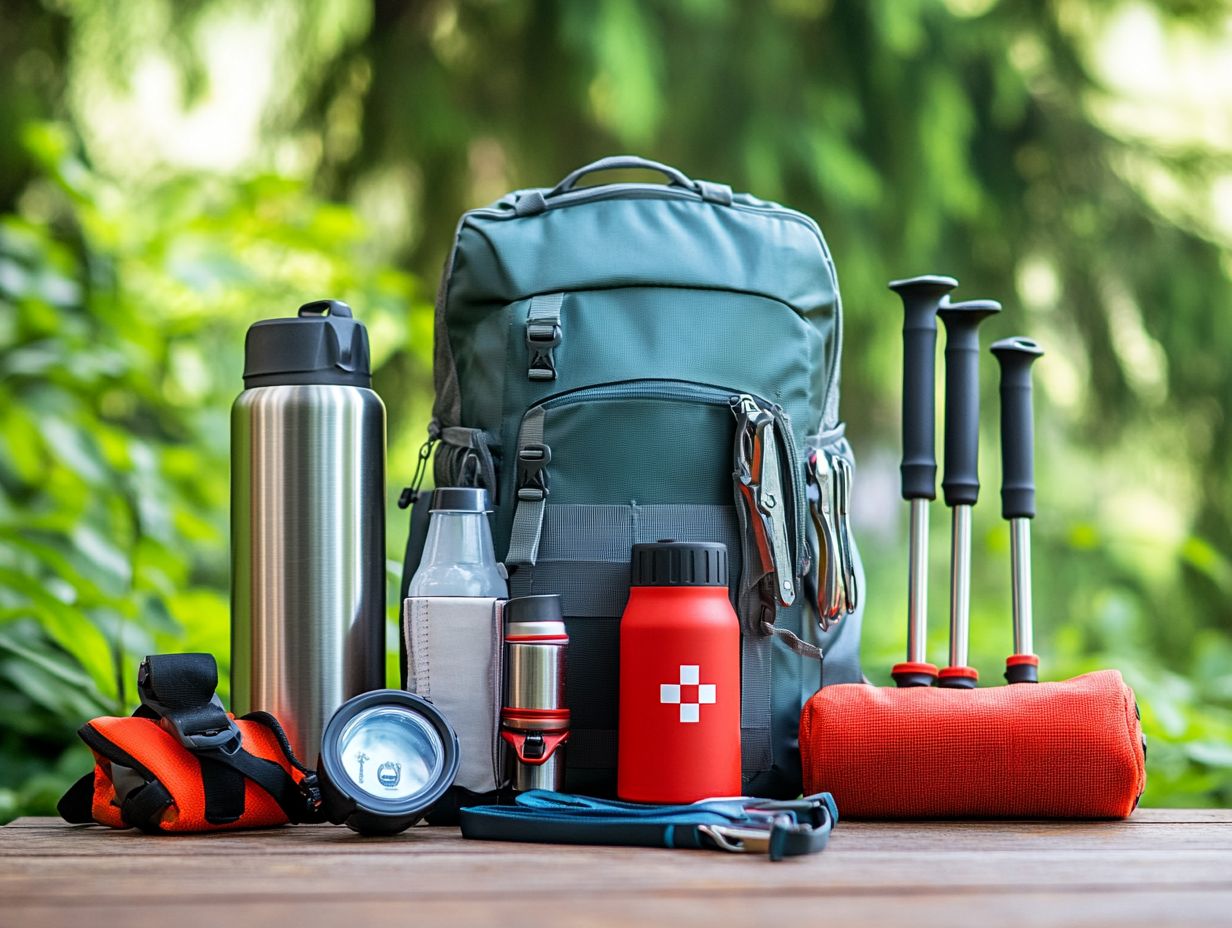
Bringing along a camera or smartphone is an excellent way to capture breathtaking views and unforgettable moments of your hiking experience. Share your adventures with the wider hiking community!
To truly make the most of these memories, opt for lightweight and durable cameras that can withstand outdoor conditions. Compact mirrorless cameras and high-quality action cameras are ideal; they re portable and deliver stunning photos with minimal effort. Of course, a reliable smartphone with a good camera can be remarkably effective for spontaneous shots.
When you step outdoors to take pictures, remember to harness natural light, explore various angles, and embrace the beauty of candid moments. Each snapshot helps weave the narrative of the hiking lifestyle, creating lasting keepsakes that inspire others to venture into the great outdoors.
Frequently Asked Questions
What are the top hiking gear accessories I need for my next adventure?
You need some must-have hiking gear accessories. A reliable backpack, water bottle, hiking boots, navigation tools, and sun protection will keep you comfortable and safe.
Why is a backpack considered an essential hiking gear accessory?
A backpack is crucial for carrying your gear and supplies. Choose one with comfortable straps and durable materials for a better hiking experience.
Do I really need hiking boots or can I use regular sneakers?
Hiking boots offer better ankle support and grip on rough terrain than regular sneakers. They are designed for hiking and help prevent injuries and discomfort.
A map, compass, and GPS device are key navigation tools. Familiarize yourself with them to avoid getting lost.
How can I protect myself from the sun while hiking?
Protect yourself from the sun while hiking, especially in hot weather. Pack a wide-brimmed hat, sunglasses, sunscreen, and lightweight clothing with UV protection.
Are there any other hiking gear accessories I should consider bringing?
Don t forget other important accessories: a first aid kit, headlamp, insect repellent, and trekking poles. These essentials are vital for emergencies and comfort. A Garmin inReach also boosts your safety and navigation.

